Managing reviews for a business across different review management platforms is complicated enough.
Add to this several more storefronts, franchises, or branches, and suddenly, multi-location review management gets even more overwhelming. Business reviews are often scattered across multiple channels like Google, Facebook, Yelp, etc.
No matter where your customers leave reviews, they always expect your acknowledgement and quick responses. But that’s not all. Even if one dissatisfied customer leaves one negative review in the wrong place, the entire reputation of your business goes for a toss.
So, here’s the thing; businesses cannot afford to ignore them. 60% of consumers say negative reviews made them not want to use a business.
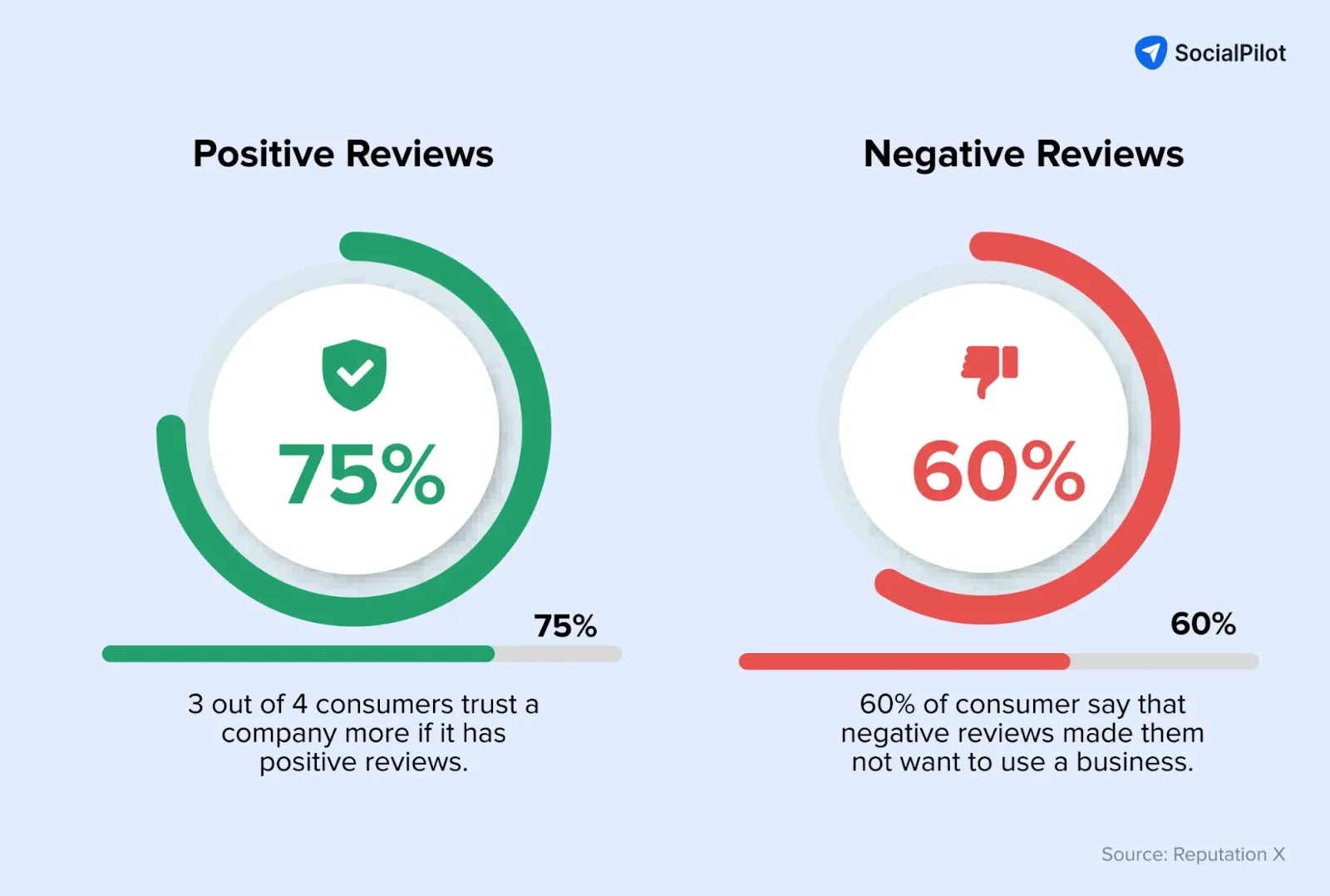
When multiple-location businesses deploy the right strategies, it helps them simplify the process and strengthens their brand reputation.
Before diving into these strategies, let us first understand what multi-location review management is.
What is Multi-location Review Management?
Simply put, it is the process of overseeing and managing online reviews for a business that operates at more than one location. These reviews are managed across multiple review platforms like Google reviews, Yelp, Facebook, etc.
So, obviously, the process is hard to get through manually, and businesses often depend on multi-location reputation management software to manage all the reviews across all locations from one dashboard.
But, multi-location review management is not just confined to reading reviews and responding to them. This process also involves understanding how each branch/location is doing and spotting the patterns in reviews (like if 3 stores are getting complaints about rude staff, you know it’s a bigger problem).
Overall, this process, if done right, can help you boost not just your brand reputation, but also your rankings in local SEO.
Let’s now understand how to manage business reviews and best strategies that can make this process effective and effortless!
How to Manually Manage Business Reviews on Google Business Profile
Did you know that 90% of consumers read reviews before they visit a business? That being said, which one do you think is the most popular review generation site?
Undoubtedly, it’s Google. When researching a business, we all find ourselves endlessly scrolling through the Google review section. This makes managing Google reviews important for businesses.
Here’s how businesses can manually (yes, we are discussing the old-school way) manage their reviews on Google:
Step 1: Claim and Verify All Your Business Locations
The first and foremost step is to ensure that each of your business locations is claimed and verified on Google Business Profile. If you haven’t verified the profile yet, just go to the home page and click on “Verify now” to verify your profile.
Next, Google will send you a verification code to your email. Just enter it, and voila, your Google Business location is now verified.
Step 2: Make Review Monitoring a Daily Habit
Think of your reviews like customer conversations – if someone was talking to you in person, you wouldn’t ignore them, right? The same rule applies online. Checking reviews regularly helps you understand your customers and engage with them. Additionally, it shows that your business cares about their opinion.
Make it a daily habit to check reviews. Take a few minutes to read new reviews and respond to them. Thank your happy customers for their kind words and address the concerns of the unhappy ones.
A quick, thoughtful response can help turn around a bad customer experience. Take it as a chance to make it right. A little attention goes a long way in building trust and keeping your reputation strong across all your locations.
Step 3: Respond Promptly and Personally
Here’s the hard truth: just responding is never enough. A prompt response is the key. A study shows that 53% of customers expect businesses to respond to their online reviews within a week.
Also, don’t send your customers those stereotypical, mechanical replies. Personalize them. Tailor each response in a way that addresses the specific concerns of the person reviewing, and always thank the reviewer for their feedback.
Step 4: Maintain a Consistent Brand Tone
While personalization is important, maintaining a consistent tone and policy across all locations solidifies your brand’s voice and keeps communication clear. Develop a standard operating procedure for responses that reflect your brand’s values and professional standards.
The key here is to define a brand voice and then develop a template for different types of reviews (positive, negative, neutral) to make sure your responses are well-aligned with your brand’s values.
The below infographic showcases different tones that brands can follow based on their voice dimensions, simply choose a voice dimension that best suits your brand and start experimenting with different tones to find your best match.
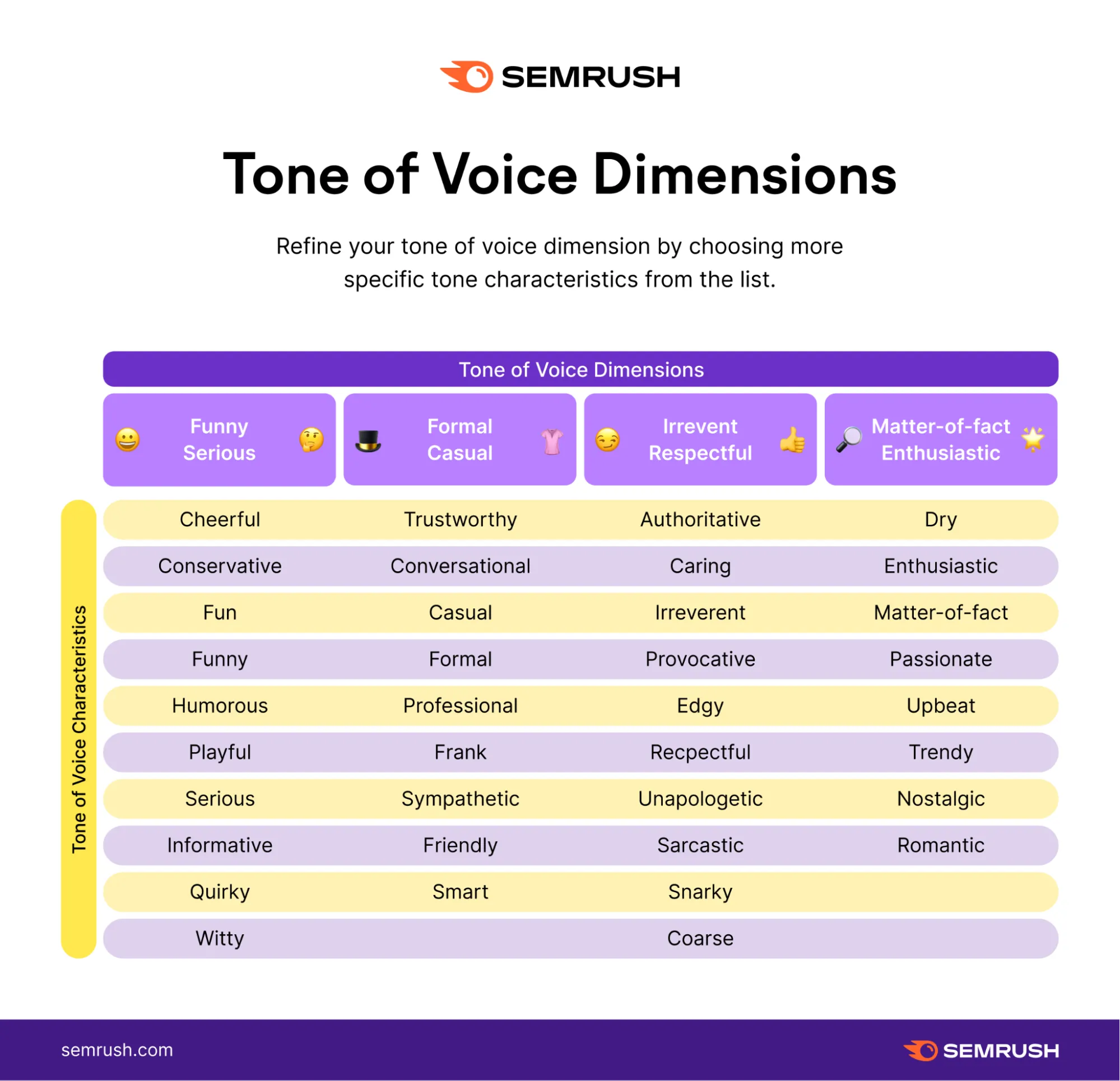
Step 5: Track and Analyze Feedback
Managing reviews is not just about reading and replying. You must also leverage the insights you get from reviews to improve your business.
But how? Enter GBP Insights. These are analytics and data provided by Google to help you understand how customers are interacting with your business profile. Simply sign in to your Google Business Profile Manager and click on the “Insights” tab to access this data.
This will give you a deeper insight into your customer actions, review analysis, and search queries, helping you understand the overall dynamics of your customer engagement.
Step 6: Report Fake or Inappropriate Feedback
Spammy, misleading, or outright false reviews can harm your business’s reputation if left unchecked. Maybe it’s a competitor leaving fake one-star ratings or a bot-generated review that makes no sense. Either way, you don’t have to just sit back and take the hit. Learn to spot these fake reviews, so you can report them.
Google allows you to report and request the removal of false or inappropriate reviews. You can do this manually by going to the review, clicking the three dots, and selecting “Report review,” as shown in the image below.
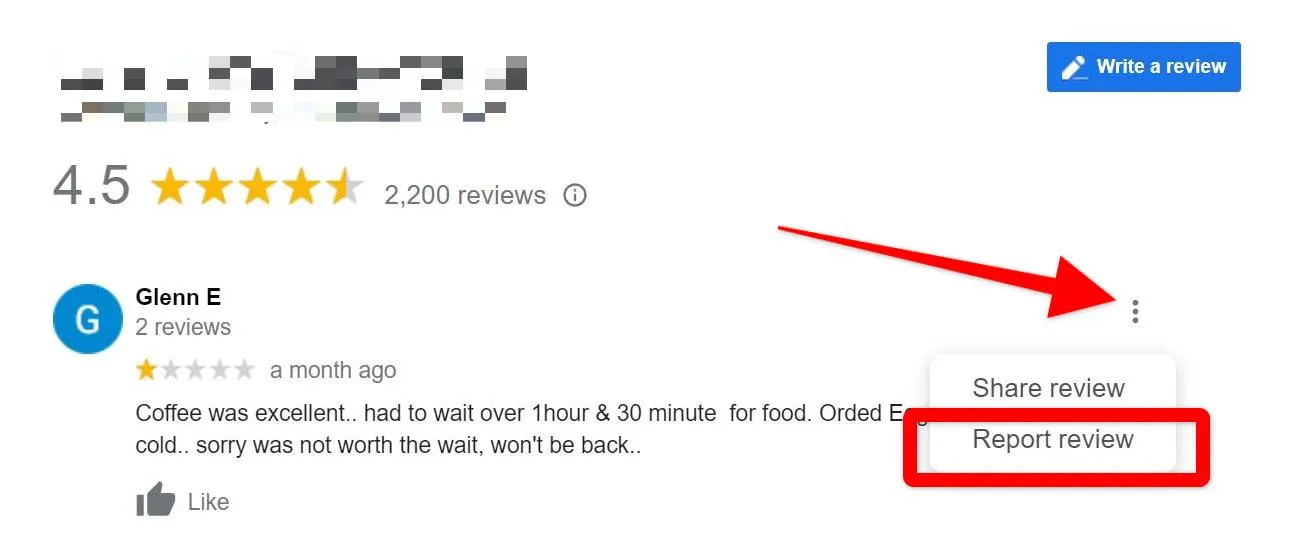
In the meantime, draft a professional reply while waiting for Google to take action. This will show your potential customers that you’re proactive and transparent.
Common Challenges of Manual Review Management
Sure, managing Google reviews manually is possible, but let’s be honest, it’s a massive time sink. What starts as a manageable task can quickly turn into a never-ending game as your business grows.
More locations mean more feedback to track and more chances to drop the ball.
Here’s why handling reviews manually can turn into a logistical nightmare:
1. A Never-Ending Process
It’s not just about accumulating feedback; every single one of them needs to be read, analyzed, responded to, and sometimes even followed up on. Now, repeat this process for all your business locations, and suddenly, your inbox is flooded with feedback. Before you know it, you’re spending hours just sifting through customer comments, trying to keep up.
The smarter move? Automate the review management process. With the right tools, you can track, respond, and analyze feedback without it consuming your entire workday. Less stress, more efficiency, and a lot more time for what really matters – growing your business.
2. Lack of Centralization
Manually tracking reviews across Google, Facebook, Yelp, TripAdvisor, and other review platforms is like trying to organize a messy room, and that too without a closet. It can get really chaotic. Each location has its own set of reviews, different platforms have different feedback, and keeping up with it all feels like juggling many balls at once.
Using a Google review management tool with a centralized dashboard or a consolidated tracking system can be your saving grace. It streamlines feedback from all locations in one place, making it easier to manage and respond efficiently.
3. Mixed Messages and a Confused Brand Image
Imagine walking into the same coffee shop in two different locations – one barista greets you with a warm smile, and the other barely acknowledges you. Feels off, right?
That’s exactly what happens when responses to reviews aren’t consistent across different locations. Some might sound polished and professional, others too casual, and some might not respond at all.
Customers notice this inconsistency, and it can make your brand feel disorganized and unreliable. The fix? A simple, clear response strategy. Create pre-approved templates and brand guidelines so every response feels consistent, professional, and on-brand. When every location speaks the same language, your customers know what to expect.
4. Missing out on Engagement Opportunities
Reviews aren’t just a box to check; they’re a chance to connect with your customers.
A five-star review? That’s not just praise; it’s an opportunity to build loyalty and turn a happy customer into a lifelong fan. A frustrated customer leaving a complaint? That’s not just criticism; it’s your chance to show them you care and win them back.
But when you’re drowning in reviews, it’s easy to overlook valuable interactions. The result? Customers feel ignored, engagement drops, and your brand loses credibility. Setting up review alerts and response timelines ensures that every important review gets the attention it deserves – on time, every time.
By now, we know that manually managing customer reviews can be overwhelming, especially for businesses looking for multi-location management. So, what’s the solution? Automation.
Now, let us understand how automation can help businesses seamlessly manage their reviews and overall reputation.
Automated Review Management for Multi-Location Businesses
Manually managing reviews across multiple locations is outdated, inefficient, and, frankly, a waste of valuable time. But automating reputation management can offer you multiple benefits and help build stronger customer relationships, all without breaking a sweat.
Here are some ways in which automated review management can help multi-location businesses:
1. Stay Consistent Across Locations
Managing reviews manually across various locations can be intimidating. Imagine a scenario where one location responds professionally, another forgets to reply, and a third goes rogue with an off-brand tone. This inconsistency can confuse new customers and weaken your brand’s credibility.
With automated review management, you can standardize responses while still keeping them personalized. Pre-configured templates ensure that every response aligns with your brand’s voice, and AI-powered tools can help craft thoughtful replies in seconds. This way, every location stays on the same page, and no review, good or bad, gets ignored.
2. Less Time, Improved Efficiency
Let’s be honest – sifting through dozens (or hundreds) of reviews every day is exhausting. Manually tracking and responding to reviews takes up valuable hours that could be better spent improving your services or engaging with customers. The more locations you manage, the more chaotic it gets.
By automating review monitoring and responses, you cut down on repetitive tasks while ensuring timely engagement.
Instead of manually logging into different review sites, an automated system collects all your reviews in one place, flags urgent ones, and even suggests responses. That means less stress for your team and more time to focus on what truly matters, i.e., delivering great customer experiences.
3. Easy Scalability for Growing Businesses
As your business expands, so does the challenge of keeping up with customer reviews. What worked for three locations won’t work for 30.
Reviews pile up, responses slow down, and suddenly, you’re drowning in unaddressed feedback. The bigger you grow, the more you need a system that can keep up.
That’s where automation shines. Whether you manage five locations or 500, a scalable reputation management system adapts to your needs. It can handle an increasing volume of reviews, assign responses efficiently, and ensure that no location gets left behind. So, no matter how fast you expand, your customer experience remains top-notch.
4. Access to Insights & Data-driven Analytics
Your reviews aren’t just words on a screen- they’re full of valuable insights. Patterns in customer feedback reveal to the store manager what’s working and what’s not. Maybe your Chicago store location gets praised for excellent service while your Miami branch gets complaints about long wait times.
Without proper analysis, you could be sitting on game-changing data without realizing it.
Automated review management tools turn raw feedback into actionable insights. They analyze trends, detect recurring complaints, and highlight areas that need improvement. Armed with this knowledge, you can make data-driven decisions that enhance the customer experience and keep your business ahead of the competition.
5. Engage Better and Build Relationships
Most businesses see reviews as something they have to deal with. But what if you saw them as an opportunity instead? Customers who leave reviews, especially positive ones, are already engaged with your brand. Ignoring them is like losing a brand advocate.
With automation, you can stay on top of review engagement effortlessly. Instant notifications ensure you never miss a chance to thank a loyal customer or turn a negative experience into a positive one.
Quick, thoughtful responses make customers feel valued, increasing the chances of repeat business and positive word-of-mouth.
6. Boost Your Local SEO
Google loves businesses that actively engage with reviews. The more reviews you collect and respond to, the better your chances of ranking higher in local search results.
A location with fresh, positive reviews and timely responses appears more trustworthy to both Google and potential customers.
Automating your review management can make this possible. It helps maintain a steady flow of reviews and responses, which signals to search engines that your business is active and customer-focused. Higher rankings mean more visibility, more foot traffic, and, ultimately, increased sales. It’s a win-win!
7. Protect Your Business Reputation
A single bad review may not seem like a big deal until it starts influencing potential customers. Unaddressed negative feedback can snowball, damaging your brand’s reputation. The longer a bad review sits without a response, the worse the impact.
With automation, you can catch and address negative reviews before they become a problem. Instant alerts ensure you’re aware of issues as they arise, giving you the chance to turn things around. A well-handled complaint shows customers (and prospects) that you genuinely care, often turning an unhappy reviewer into a loyal customer.
Managing Google reviews for multiple locations manually can be overwhelming. While Google Business Profile (GBP) does provide a way to oversee multiple listings, it lacks flexibility, making it difficult for businesses with multiple locations to monitor, respond to, and analyze reviews efficiently.
That’s where SocialPilot Reviews comes in. This powerful, centralized solution simplifies multi-location review management by bringing everything under one easy-to-use dashboard.
Here’s how SocialPilot can help you streamline the process:
1. Connect Your Google Business Profiles Seamlessly
No more jumping between multiple accounts! With SocialPilot Reviews, you can connect multiple GBP accounts in one place. Simply link your business profiles by going to the SocialPilot Reviews > Dashboard > Brands > Add a Brand, as shown in the image below.
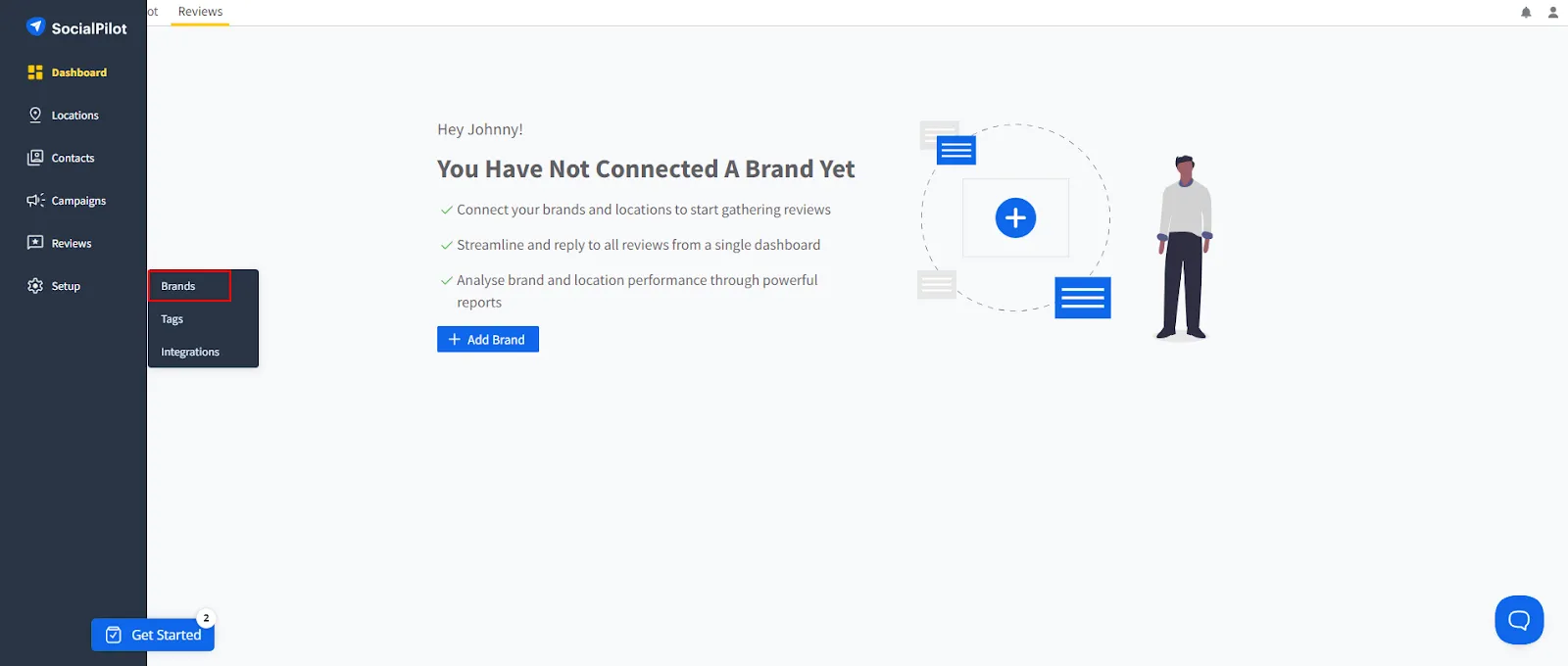
Soon after, SocialPilot will automatically fetch reviews across all locations.
This eliminates the hassle of logging into different accounts, allowing you to see and manage all your reviews from one unified dashboard. This can help you save time and keep things organized.
2. View, Search, and Respond to Reviews Effortlessly
Manually tracking reviews across multiple locations can result in missed feedback and delayed responses. For easy access, SocialPilot brings all your Google reviews into one centralized hub.
This can help you:
- Search through reviews using filters to quickly find feedback for specific locations.
- Analyze review sentiment to identify trends and recurring issues.
- Respond to reviews instantly from the dashboard, ensuring every customer receives a timely reply.
The image below shows how businesses can easily manage reviews for their multiple locations using the SocialPilot Reviews’ centralized dashboard.
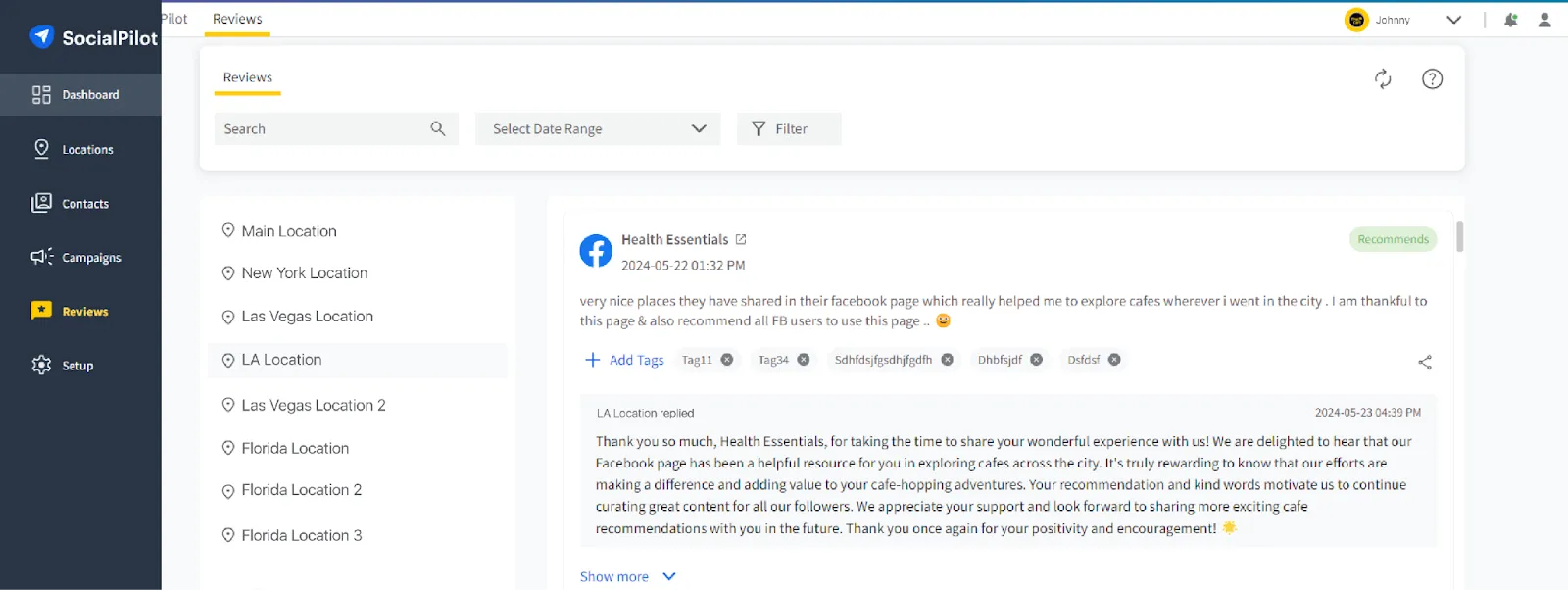
With SocialPilot’s intuitive interface, you never have to switch between multiple GBP accounts. Location managers can manage everything in one place, making review management smoother and more efficient.
3. AI-powered Review Responses
Keeping up with customer reviews can sometimes feel like a never-ending task. Just when you’ve responded to one, another pops up! So, what’s the solution? SocialPilot Reviews’ AI-powered responses take the hassle out of replying.
With this feature you can craft a thoughtful and professional reply within seconds, and that too without losing that human touch.
The best part? You stay consistent across all locations, ensuring every response aligns with your brand’s voice. No more scrambling to come up with the perfect reply or worrying about delayed responses. With AI doing the heavy lifting, you can engage with customers faster, boost trust, and maintain a stellar online reputation.
4. Showcase Customer Reviews to Build Trust
Positive reviews are a goldmine for your brand’s reputation. Why let them go unnoticed? SocialPilot allows you to highlight glowing customer feedback by integrating reviews into your marketing strategy.
You can share positive feedback on your website and social media platforms directly through SocialPilot Reviews, boosting credibility and attracting more customers. This not only enhances your online reputation but also encourages more people to leave reviews.
So, automation can indeed make things seamless when it comes to multi-location review management.
In the next section, we will talk about some effective review management strategies for businesses looking for seamless multi-location management.
Strategies for Effective Multi-Location Review Management
Managing multi-location business reviews is all about building a system that works at scale. The goal here is to stay consistent, be efficient, and engage with customers in a way that strengthens your brand’s reputation.
With customers making their buying decisions based on what they read online, you can’t afford to take a scattered approach.
Here are some effective strategies to simplify the multi-location management of customer feedback:
1. Centralized Monitoring with Review Management Tools
Managing customer reviews across all your social profiles, review sites, and locations is a tedious task.
When dealing with hundreds of locations, going to every review site and manually replying will not work. You need a centralized system to monitor and manage customer reviews.
That’s where dedicated review management tools come into play. They let you pull reviews from different review sites, such as Google, Facebook, TripAdvisor, G2, and many other industry-specific sources, into one unified dashboard for each location.
In addition to responding to reviews and feedback, you can use these tools’ analytics features to visualize review data, compare location performance, and analyze sentiments. This enables you to make data-driven decisions to improve your reputation across locations.
2. Work Smarter by Automating Routine Tasks
The truth is that some parts of multi-location review management are just plain repetitive. Tasks like manually requesting reviews, tracking feedback, and responding to common queries are repetitive in nature and can eat up hours of your time.
That’s where automation saves the day.
Set up automated emails or text review request messages that ask for reviews right after a customer makes a purchase; no more chasing feedback manually!
You can also automate responses to common reviews. A five-star shoutout? Let AI send a quick “Thank you!” A negative review? Trigger a follow-up so your team can jump in and turn things around.
The best part? It helps you save time, reduce manual effort, and never miss an opportunity to engage with customers.
3. Encourage Local Reviews
Reviews can make or break the reputation of your business. 72% of people say they are more likely to trust a local business with positive feedback.
However, continuously getting a stream of positive reviews for each location is a little tricky. You need to nudge your happy customers to leave good reviews.
The key is to make the process of leaving reviews super-easy, fun, and rewarding. You need to give your customers a way to reach the review platform through your website, social media, or email signature.
Don’t stop there.
Put QR codes in physical locations that direct customers to your review pages. This technique attracts fantastic hyperlocal reviews.
But the real nudge is when you give them something back in return for their reviews. For example, you can offer a discount on their current bill or their next visit as a reward. This can encourage customers to leave feedback.
4. Create a Uniform Response Policy
Managing reviews can often be complicated, especially for multi-location businesses.
To keep things smooth and professional, your business needs a clear, consistent game plan for handling customer feedback. That means setting some ground rules for how your team responds to reviews across all locations.
Think of it as your review response playbook. It should cover things like:
- Brand voice and tone (Do you keep it formal, friendly, or somewhere in between?)
- Formatting and vocabulary (Are emojis a yes or a no-go? How do you sign off?)
- Professionalism guidelines (What’s acceptable, and what’s definitely not?)
- Branding consistency (Making sure every response aligns with your company values)
The good news? You probably already have something like this in place for customer interactions.
Now, it’s just a matter of tweaking it and creating a unified response policy that works well for your multi-location business. This way, every response, be it good or bad, can be handled in a polished and professional way.
5. Address Negative Feedback Promptly
Review management isn’t always going to be all hunky-dory. Negative reviews are part and parcel of the whole process. Your aim should be not to let things escalate out of your hands.
For that, reputation managers at every business venue should be prepared on how to handle negative reviews. The biggest rule? Address the issue promptly. An angry customer left waiting for a response is just going to get angrier.
Establish a strategic process that enables you to monitor and prioritize negative reviews quickly. You can set up alerts for one-star ratings or damaging comments.
When you approach negative feedback, keep your response professional and empathetic, whether you are able to provide a resolution or not.
You should also aim to move the conversation from an open space to a closed space, such as DMs, so that it doesn’t attract more public attention.
Over time, you’ll build trust that your brand takes accountability seriously across all locations.
On social media platforms, customers often share the good, the bad, and the ugly experiences that they’ve had with brands, local stores, and franchises.
So, you ought to be there when they talk about a particular branch of your business.
However, having one global brand account with a broad messaging won’t cut it for a multi-location business. To have a genuine connection, you need to have multiple accounts on social media tailored for each individual location.
Freddy’s Frozen Custard & Steakburgers has created a separate Facebook page for every location they have in Texas.

Creating a separate social media account for each location will enable you to create content, promotions, and updates relevant to that locality’s population.
Beyond just making content, you can use them to monitor location-specific reviews and feedback better and respond promptly. Also, when your customers want to praise you, they will have a proper and localized destination to reach you.
You can further use their shared post about your brand as user-generated content to generate more trust and authenticity.
Overall, an active, location-focused social media strategy is a powerhouse for multi-business review management.
Wrapping Up
In this digital age, multi-location review management isn’t something you can afford to ignore.
Customers are out there constantly sharing their opinions about your brand and influencing the decisions of many others. A bad experience at one location can drag down your entire brand’s reputation, while a glowing review can boost trust across all your locations.
That’s why you must proactively implement the right multi-location review management software like the SocialPilot’s Review tool, along with the proven strategies to protect and enhance your brand’s image across all touchpoints.
Putting these strategies into action can also bring small businesses some much-needed respite. So, make sure to add them to your reputation management arsenal.
Now it’s your time to apply these strategies.



